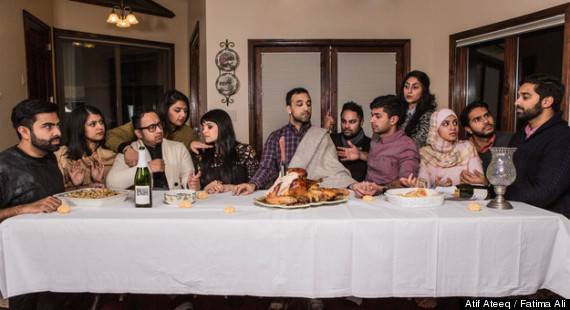A couple of days ago I posted a link to this photo from the Huffington post article Muslim “Last Supper” Photo Offers Interfaith Tribute to Da Vinci’s Masterpiece.
The organizer Fatima Ali commented
“For this year’s photo, we wanted to do something that, in its own humble way, aimed to bridge the gap between Eastern and Western cultural and religious norms. We looked up the painting, assigned each person a character, and meticulously tried to mimic the image, while also making it our own.”
The pictured group enjoyed the process of putting a different spin on the the iconic artwork. “Most of the people pictured in this photo have been active members of the Islamic Center at NYU, and I think one of the greatest values we all have shared is this overwhelming sense of community and religious unity,” Ali said. “I don’t mean just Muslim unity or Muslim community, I mean on a more universal level, being respectful and considerate of all faiths and religious communities.”
Not surprisingly, the photo elicited a varied response from Christians. Some are delighted by this depiction of Christ and his followers with faces that look more authentic than the white faces we usually see. Others are appalled by Muslims depicting what they view as a sacred Christian event.
Today, I am looking at this photo as I read through the meditations in Monastery Journey to Christmas by Brother Victor-Antoine D’Avila-Latourrette. He writes: Jesus is the Prince of Peace whose face the whole world longs to see. And I would add – longs to come home to. That desire, that longing to see the authentic face of God and to come home to a community into which all the peoples of the world are invited is what I sense in the photo above. I think that in the hearts of all humankind there is a deep ache for the coming of a saviour who will lead us home together. As Brother Victor says:
Christ, the Messiah, the Key of David, comes to unlock for all, Jews and gentiles alike, the doors of the kingdom of God. He alone possesses the keys and it will be he who invites all, be they just or sinners, into his eternal banquet. No one shall be excluded. This is precisely the good news of the Gospel he will proclaim one day.
The great O Antiphon developed during the church’s early centuries speaks of this longing. On December 19th, we read:
O Root of Jesse sign of peace,
Before whom all the nations stand in awe;
Kings stand silent in your presence;
The nations bow down in worship before you.
O come and set us free;
Delay no longer in your love.
As I look out at my seemingly dead Seattle garden, covered in frost and snow, I can fully appreciate this image. Winter seems to have destroyed all life, yet hidden in the earth, the roots still live, growing stronger, reaching deeper ready to emerge in the coming spring. For the Jewish people there was a long winter of centuries before Jesse’s Root, sprouted forth with the coming of Christ, the Messiah.
When Christ first appears he is like the first sprouts of spring growth – weak, vulnerable, tiny compared to the tree that will grow. This is the Christ whose remembrance we celebrate at Christmas. Yet in that tiny shoot is the hope and promise of what is to come – a tree that will spread over all the earth, a saviour for the whole world whose power and scope is far greater than any of us could ever imagine. This is the Christ for whose coming we wait with joyful anticipation. This is the Christ who fills our hearts with longing for the future.
This tender shoot, this vulnerable child whose very birth reveals the upside down nature of God’s kingdom is an ensign for the nations, a flag towards which all people will be drawn and that includes the Muslims. The word we translate as “nations” had a very different meaning for the Jews. “Gentiles” were everyone who was not Jewish. It encompassed all peoples outside Israel, opening God’s promise of salvation to all cultures and countries. The new kingdom Christ ushered in is open to the entire world. Christ the Messiah, the tiny Branch which will become a mighty tree will break down walls and barriers between all people.


2 comments
I love this, and think the painting more accurate given that the composition of the early church consisted largely of the Arabic (muslim?) folks from the nations surrounding Israel?
Thanks Steve. I think you are right.